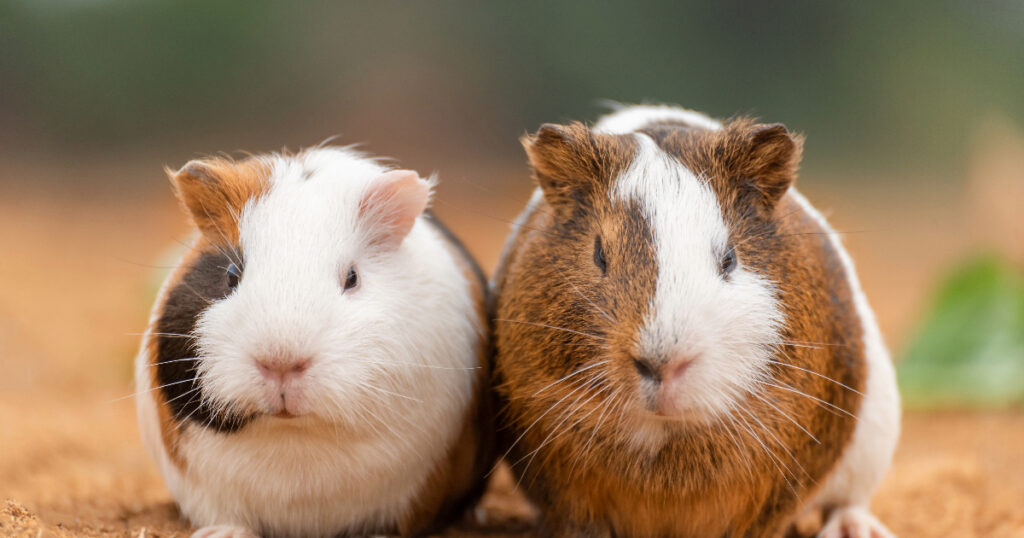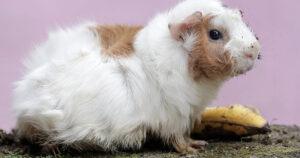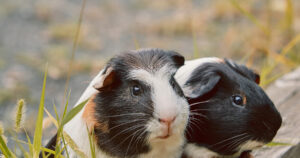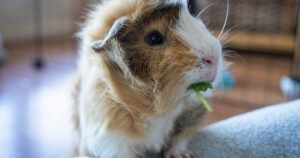Crackers are a popular snack for humans, but can our guinea pig pets enjoy them too? As herbivores, guinea pigs require a diet primarily composed of hay, fresh vegetables, and limited amounts of fortified pellets. Their digestive systems are not equipped to properly process foods like crackers which are made with wheat flour, salt, and oils.

While tiny pieces of low-salt crackers given very occasionally will likely not cause harm, they provide no nutritional value. It is best to avoid feeding crackers to guinea pigs as part of their regular diet.
Nutritional Value of Crackers for Guinea Pigs
Crackers are often made from refined grains which have had the nutritious bran and germ removed during processing. What remains is mostly carbohydrates without much fiber or other nutrients.
Guinea pigs require a high fiber diet, ideally getting the bulk of their nutrition from timothy hay. Crackers do not provide this necessary roughage that promotes good digestion.
Additionally, crackers contain added salt and oil during processing which guinea pigs have no need for. Guinea pigs’ bodies are so efficient at retaining sodium that excess salt can put them at risk of sodium ion toxicity. They do require some healthy fats, but the small amount found in their pellets and vegetables is plenty.
The minimal vitamins and minerals present in flour and grains are further depleted during the baking process. Notably absent are:
- Vitamin C: Guinea pigs cannot internally produce vitamin C like humans, so it must come from fresh foods. Deficiency causes the painful and potentially fatal disease scurvy.
- Vitamin A: This vitamin supports eye and skin health as well as proper immune system functioning in guinea pigs.
- Calcium: While guinea pigs do need some dietary calcium, excessive amounts can lead to stone formation. The calcium in timothy hay meets their needs.
With no vitamin C, unnecessary sodium and fats, and only trace amounts of other micronutrients, crackers offer no real nutritional value for guinea pigs. Their diet should instead focus on hay, vegetables, and pellets.
Key Takeaway: Crackers lack vital nutrients like vitamin C and calcium that guinea pigs need, providing no real nutritional value.
Health Risks of Feeding Crackers to Guinea Pigs
Given their poor nutritional makeup, regular consumption of crackers can negatively impact guinea pig health. Some specific risks include:
Gastrointestinal Upset
The digestive systems of guinea pigs are quite delicate, adapted to fibrous grasses and plant matter. The refined flour, oil, and salt used to make crackers can irritate the gut lining.
Symptoms like diarrhea, bloating, and loss of appetite may result. Dehydration can occur if a guinea pig refuses food and water due to GI upset.
Obesity and Fatty Liver Disease
With no fiber and lots of quickly digestible carbohydrates, crackers have a very high caloric density for guinea pigs. Just small amounts on a regular basis can lead to obesity.
Obese guinea pigs are prone to developing hepatic lipidosis, also called fatty liver disease. This painful condition causes fat to accumulate in liver cells and can lead to cirrhosis.
Cardiovascular Issues
As mentioned, the sodium and fat content of crackers is inappropriate for guinea pigs. Excess dietary sodium is directly linked to high blood pressure in guinea pigs.
Hypertension combined with increased cholesterol from crackers puts strain on the heart and blood vessels. Signs of heart failure may result.
Dental Problems
The hard, crunchy texture of crackers requires considerable chewing force. This can actually wear down guinea pig teeth unevenly.
Constant crunching can also cause painful trauma to the gums. Dental discomfort will deter guinea pigs from properly eating their hay and vegetables.
Calcium Stones
Though crackers themselves contain little calcium, the digestive upset they cause reduces calcium absorption.
Low blood calcium then stimulates the body to release more calcium from bones. This excess calcium passes through the urinary system, potentially forming stones.
So in a roundabout way, regularly feeding crackers may increase guinea pigs’ risk for developing calcium-based bladder or kidney stones.
Key Takeaway: Regularly feeding crackers risks obesity, dental issues, GI problems, heart disease, and urinary stones in guinea pigs.
Healthy Diet for Guinea Pigs
To meet guinea pigs’ nutritional needs and avoid health problems, their diet should consist of:
- Unlimited timothy hay, to provide fiber for digestion and wear down teeth
- 1/8 cup guinea pig pellets daily, for vitamin C, protein, and mineral balance
- 1 cup mixed vegetables like romaine, bell peppers, cilantro
- 1-2 tablespoons of fruits like strawberries, melon, kiwi 2-3 times per week
- Fresh water always available
The bulk of this diet is hay, which guinea pigs naturally graze on all day long. Small but frequent meals of fresh produce keep vitamin C circulating.
Avoid sudden diet changes, instead gradually transitioning guinea pigs over a week or two. This prevents gastrointestinal upset.
Also, each guinea pig has unique nutritional needs based on age, weight, and health status. Consult an exotics veterinarian to tailor the proper diet.
Guinea Pig-Safe Low-Calorie Treats
While crackers themselves should be avoided, guinea pigs can occasionally enjoy treats. Some healthy, low-calorie options include:
- A few fresh herb sprigs like cilantro, parsley or basil
- Melon rind – just the outer green flesh, not the peel
- Zucchini ribbons sliced with a vegetable peeler
- Celery leaves attached to the stalk
- One baby carrot
- Half a large strawberry
- Fruit-flavored timothy treats – no added sugar
- Wood chews provide enrichment
Always slowly introduce new foods, watching for signs of an allergic reaction. And limit treats to no more than 2-3 times per week max, so as not to unbalance guinea pigs’ nutritional intake. The other 80-90% of the time, hay and veggies should be offered.
Can Guinea Pigs Have Certain Types of Crackers?
There are countless varieties and brands of crackers on the grocery store shelves. But it’s important to remember that all types of crackers – whether salty, sweet, or cheese-flavored – are still processed wheat flour and oil products with minimal nutritional value at best.
Here’s a run-down of some popular cracker types that should not be part of a guinea pig’s diet:
Saltine Crackers
One of the most basic cracker varieties, saltines contain lots of added sodium and baking soda for a light, flaky texture. This excess salt is problematic for guinea pigs prone to sodium ion toxicity.
Graham Crackers
While graham flour is made from whole wheat, graham crackers still undergo a baking process depleting nutrients. Added sugar provides empty calories with no health benefits for guinea pigs.
Animal Crackers
Despite being shaped like animals, these crackers provide no specific nutritional advantage. The flour, sugar, and baking render them unhealthy. Additionally, their sweetness may encourage overconsumption resulting in obesity.
Cheese Crackers
Any type of cheese or dairy ingredient poses digestive upset for guinea pigs who are lactose intolerant. Even aged cheeses still contain milk proteins their bodies cannot properly digest.
Vegetable or Fruit Crackers
Crackers made with vegetable or fruit powders may seem healthy. But these flours still undergo processing and baking, rendering any vitamins or minerals minimal. They are no substitute for fresh produce.
Oyster Crackers
The high sodium content of these crackers flavored with just a hint of oyster makes them inappropriate. Plain crackers with a sprinkling of nutritional yeast flakes provide a better salt-free crunchy treat.
Crackers and Guinea Pig Dental Health
The hard, crunchy texture of most cracker varieties requires quite a bit of chewing force from guinea pigs. This can lead to uneven tooth wear and dental pain.
Guinea pigs’ teeth constantly grow throughout their lives. The fibrous stems and strands in hay work to naturally file down teeth with chewing motions.
Without adequate hay intake, misaligned teeth can develop into painful dental spurs or overgrown points. These make eating very difficult.
Crackers may momentarily satisfy chewing urges, but leave teeth uneven. Guinea pigs require near-constant access to timothy hay racks to promote dental health.
Guinea Pig Digestion and Crackers
Guinea pigs have a very specialized form of digestion not equipped to handle processed foods like crackers:
- A single stomach compartment lacks the acids and enzymes to break down wheat flour and oils.
- The majority of nutrient absorption happens in the large cecum. Here, fermentation of fiber by bacteria produces vitamins.
- To further extract nutrients, guinea pigs practice coprophagy – the ingestion of special soft stools called cecotropes.
- A high-fiber diet promotes movement and optimal function of the GI tract.
With their simple stomach and dependence on fiber fermentation, guinea pigs cannot properly digest the refined flour and added fats in crackers.
The lack of fiber and excess carbohydrates also disrupt healthy gut motility and cecotrope production. For these reasons, crackers should be avoided.
Guinea Pig History with Human Foods
Guinea pigs were first domesticated as livestock animals in South America over 5000 years ago. Selective breeding programs focused on docile behavior and higher reproduction rates.
Wild guinea pig ancestors in the Andes mountain regions subsisted mainly on fibrous grasses and plants. Their digestive tracts evolved to specialize in extracting nutrients from these rough vegetative materials.
As pets today, guinea pigs retain this herbivorous gastrointestinal anatomy. Their bodies are simply not designed to utilize nutrient sources like processed wheat flour and added fats.
While guinea pigs in captivity have adapted somewhat to enjoy small amounts of sugars and starches, these should make up only a very small portion of their diet.
Key Takeaway: As prey herbivores evolved to eat grasses and plants, guinea pigs cannot properly digest most processed human foods like crackers.
Are Crackers Toxic for Guinea Pigs?
Crackers are not inherently toxic or poisonous substances for guinea pigs in small amounts. Many owners report their guinea pigs have snatched unattended crackers or bits that dropped on the floor without apparent ill effects.
However, this does not mean crackers are safe or healthy to intentionally feed guinea pigs on a regular basis. The cumulative effects of inappropriate nutrition and excess calories, sodium, and fats take time to manifest as obesity, cardiovascular strain, and dental disease.
While not acutely toxic, regularly feeding crackers essentially provides “empty calories” to guinea pigs – calories devoid of nutrition. Guinea pigs’ small size and rapid metabolism make them prone to malnutrition and deficiency disorders.
Even if they appear to enjoy crackers, these processed snacks have no place in meeting guinea pigs’ dietary requirements. Owners should take care to keep crackers out of reach of curious cavies.
What If My Guinea Pig Accidentally Eats a Cracker?
Should your guinea pig manage to grab and gobble down a cracker when you aren’t looking, take a deep breath and assess the situation.
For a healthy guinea pig, a single cracker in isolation poses only minimal risk. Monitor your pet for signs of choke or intestinal upset like coughing, drooling, vomiting, diarrhea, or loss of appetite.
Offer plenty of fresh timothy hay and water. Discourage further snacking by removing any accessible crackers.
If symptoms do develop or persist, contact an exotic veterinarian right away. They can provide supportive care for gastrointestinal issues.
The main concern from an isolated cracker incident is it creating an unhealthy expectation and desire for more. Be sure to limit future access to avoid habit formation.
Overall, one accidental exposure is not cause for alarm. Simply get your guinea pig back onto their normal healthy diet.
FAQs
Can guinea pigs have Cheez-Its or cheese crackers?
No, cheese-flavored crackers often contain milk or whey powder along with oils and lots of sodium. Dairy is not digestible for guinea pigs, and the fat and salt content make cheese crackers inappropriate.
What about Goldfish crackers?
While the smiley fish shapes are cute, Goldfish contain refined flour and oils undergo high heat processing. They also tend to have higher sodium levels that guinea pigs cannot tolerate.
Can I give my guinea pig just a small piece of a cracker as a treat?
It’s best not to purposefully feed any amount of crackers, as even tiny portions provide empty calories and set up an expectation for guinea pigs to want more. Healthy treats like vegetable pieces or timothy cookies are far better options.
Are crackers less unhealthy for younger guinea pigs?
No – guinea pigs of any age should avoid crackers and all processed human foods. Younger and older guinea pigs have different nutritional needs, but wheat flour and oils are inappropriate regardless of life stage.
Can crackers impact my guinea pig’s poop?
The low fiber and high carbohydrate content of crackers compared to guinea pigs’ usual diet can definitely cause digestive upset and very loose stool. Make sure to offer plenty of hay to get their GI tract back on track.
Conclusion
While munching on crackers is an enjoyable snack for people, these processed wheat flour and oil products provide no health benefits for guinea pigs. The lack of proper nutrients combined with inappropriate levels of fat, sodium, and carbohydrates means crackers have no place in guinea pigs’ diets.
Guinea pigs require a high fiber hay-based diet along with leafy greens, vegetables, and a small fortified pellet portion. This provides the vitamins, minerals, and roughage their digestive system needs. Owners should take care to avoid feeding crackers, instead providing healthy fruits, herbs, or timothy treats for occasional variety.







